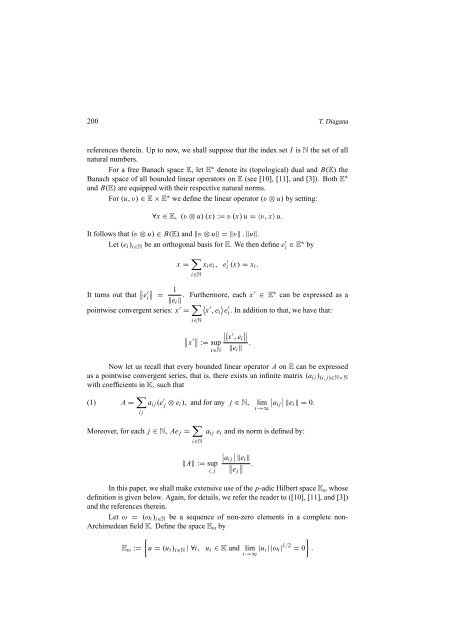T. Diagana INTEGER POWERS OF SOME UNBOUNDED LINEAR ...
T. Diagana INTEGER POWERS OF SOME UNBOUNDED LINEAR ...
T. Diagana INTEGER POWERS OF SOME UNBOUNDED LINEAR ...
You also want an ePaper? Increase the reach of your titles
YUMPU automatically turns print PDFs into web optimized ePapers that Google loves.
200 T. <strong>Diagana</strong><br />
references therein. Up to now, we shall suppose that the index set I is N the set of all<br />
natural numbers.<br />
For a free Banach space E, let E ∗ denote its (topological) dual and B(E) the<br />
Banach space of all bounded linear operators on E (see [10], [11], and [3]). Both E ∗<br />
and B(E) are equipped with their respective natural norms.<br />
For (u,v) ∈ E × E ∗ we define the linear operator (v ⊗ u) by setting:<br />
∀x ∈ E, (v ⊗ u) (x) := v (x) u = 〈v, x〉 u.<br />
It follows that (v ⊗ u) ∈ B(E) and ‖v ⊗ u‖ = ‖v‖ .‖u‖.<br />
Let (e i ) i∈N be an orthogonal basis for E. We then define e ′ i ∈ E∗ by<br />
x = ∑ i∈N<br />
x i e i , e ′ i (x) = x i.<br />
It turns out that ∥ ∥ e<br />
′ 1<br />
i<br />
=<br />
‖e i ‖ . Furthermore, each x′ ∈ E ∗ can be expressed as a<br />
pointwise convergent series: x ′ = ∑ 〈<br />
x ′ 〉<br />
, e i e<br />
′<br />
i . In addition to that, we have that:<br />
i∈N<br />
∥ x<br />
′ ∥ ∣ 〈 x ′ 〉∣<br />
, e i ∣<br />
:= sup<br />
i∈N ‖e i ‖ .<br />
Now let us recall that every bounded linear operator A on E can be expressed<br />
as a pointwise convergent series, that is, there exists an infinite matrix (a i j ) (i, j)∈N×N<br />
with coefficients in K, such that<br />
(1) A = ∑ i j<br />
a i j (e ′ j ⊗ e ∣<br />
i), and for any j ∈ N, lim ∣ ai j ‖e i ‖ = 0.<br />
i→∞<br />
Moreover, for each j ∈ N, Ae j = ∑ i∈N<br />
a i j e i and its norm is defined by:<br />
‖A‖ := sup<br />
i, j<br />
∣ ai j<br />
∣ ∣ ‖e i ‖<br />
∥ e j<br />
∥ ∥<br />
.<br />
In this paper, we shall make extensive use of the p-adic Hilbert space E ω whose<br />
definition is given below. Again, for details, we refer the reader to ([10], [11], and [3])<br />
and the references therein.<br />
Let ω = (ω i ) i∈N be a sequence of non-zero elements in a complete non-<br />
Archimedean field K. Define the space E ω by<br />
E ω :=<br />
{<br />
}<br />
u = (u i ) i∈N | ∀i, u i ∈ K and lim |u i| |ω i | 1/2 = 0 .<br />
i→∞














